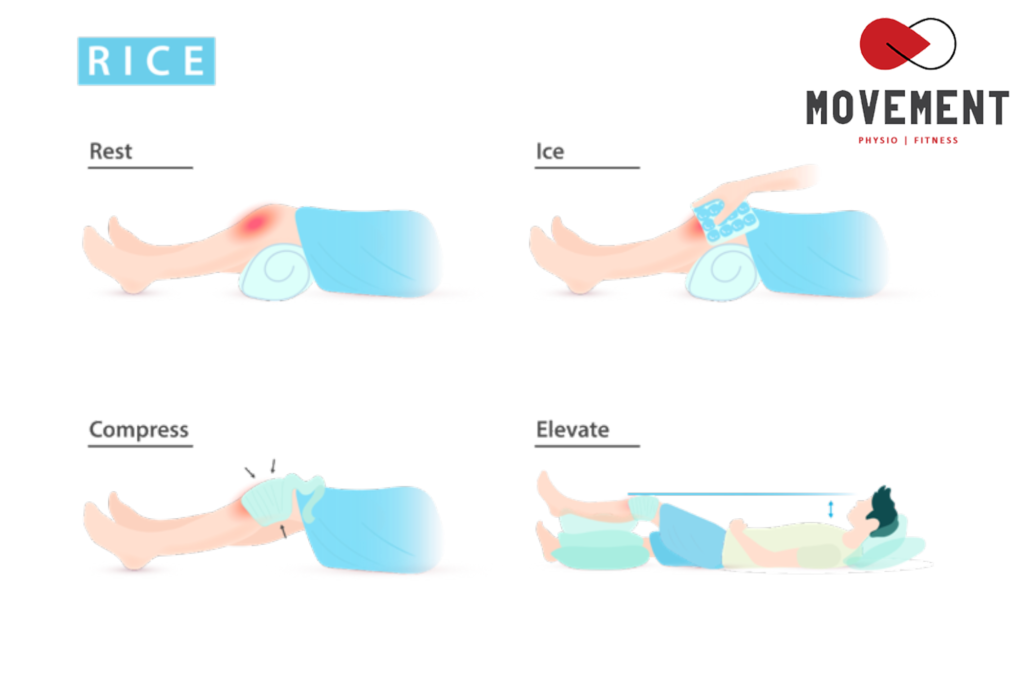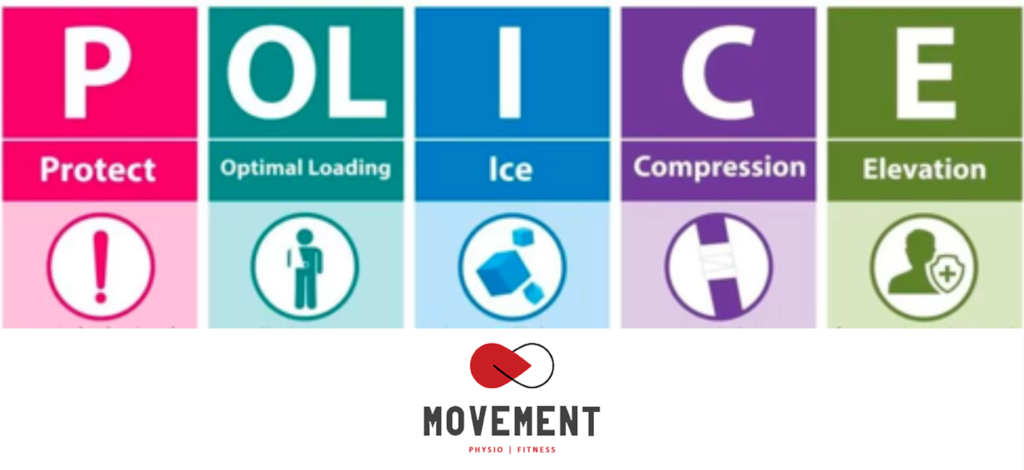In the quest for the most effective injury recovery strategy, the evolution from RICE to POLICE and now PEACE and LOVE represents a significant leap forward in the field of sports medicine and physical therapy. This transition not only mirrors the evolving landscape of injury management but also deepens our understanding of the body’s intricate healing processes. As we explore the origins, application, and reasons behind these methods, we uncover which approach truly leads to the effective management of acute musculoskeletal injuries.
The Origins of RICE
Introduced in the late 1970s by Dr. Gabe Mirkin, RICE—Rest, Ice, Compression, and Elevation—quickly established itself as the foundational protocol for the management of acute soft tissue injury. This strategy advises individuals to rest the injured area, apply ice to lessen swelling, use compression to lower inflammation, and elevate the injury to reduce blood flow to the area. Taking ankle sprains, which are a common type of injury to muscles or bones, as an example, this method should be applied first, highlighting the significance of immediate action to prevent further harm.
RICE in practice: A closer look

Component | Description |
Rest | Implementing complete rest is crucial in the initial phase after an injury. For instance, after a knee sprain during a soccer game, resting entails halting the game and avoiding any activity that places weight or strain on the knee, possibly using crutches to navigate daily activities without stressing the injured knee. |
Ice | Applying ice to the injured site involves timing and technique—using ice for 20 minutes every two hours for the first 48 hours to constrict blood vessels and reduce blood flow, thus mitigating pain and swelling. Post 48 to 72 hours, if swelling subsides, heat can be applied to the area. Always use a towel as a barrier between your skin and the ice or heat pack. Ice should also be applied after any prolonged activity or intense exercise. |
Compression | Carefully wrap the injured area with a bandage or compression wrap to provide support without being too tight, aiming to minimise swelling without impeding circulation. If the bandage is too tight, indicated by numbness, tingling, increased pain, coolness, or swelling below the bandage, it should be loosened to prevent further swelling beneath the injury site. |
Elevation | Elevating the injured site above heart level, such as placing the injured knee on a pillow stack, helps reduce swelling by facilitating venous return. This strategic position is not only for comfort but also aids in speeding up the recovery process by decreasing fluid accumulation. |
The evolution to POLICE
The medical community’s deepening understanding of the healing process led to questioning the efficacy of complete rest as prescribed by RICE. This introspection gave birth to the POLICE protocol—Protection, Optimal Loading, Ice, Compression, and Elevation. This refined strategy maintains the beneficial aspects of its predecessor while incorporating Protection and Optimal Loading to foster a more active recovery.
POLICE in action: A detailed approach

Component | Description |
Protection | The initial step is to protect the injured area to avoid further harm. For example, a sprained ankle might require an ankle brace or support boot for stability, safeguarding against harmful movements and potentially limiting weight-bearing activities with the use of crutches. |
Optimal Loading | Introduces the concept of applying a calculated amount of stress to promote healing. In the case of a sprained ankle, this may involve light weight-bearing exercises, as advised by a healthcare professional, aiming to balance rest and activity to stimulate recovery without overburdening the injury. |
Ice | Ice application continues as a key element in managing pain and inflammation, similar to the RICE method but integrated into a broader, active recovery strategy. Ice serves as both immediate aid and an ongoing part of the recovery, especially after activities that strain the injured area. |
Compression and Elevation | These elements remain vital within the POLICE method, working in conjunction to reduce swelling and facilitate fluid drainage. Compression provides support and aids in swelling management, while elevation promotes drainage away from the injured area, contributing to a holistic recovery approach that incorporates protection, activity, and swelling control. |
The historical context and their impacts
Transitioning from RICE to POLICE is more than a mere change in acronym; it signifies the medical community’s commitment to evolving and refining recovery strategies based on evidence-based practices. This evolution from rest ice compress and elevation (RICE) to protection, optimal loading, ice, compression and elevation (POLICE) illustrates a shift towards personalised injury management, taking into account the unique conditions of each injury and individual.
Merging insights for a comprehensive recovery approach
Integrating insights from both RICE and POLICE clarifies that the discussion isn’t about choosing one method over the other. Initially, RICE offers a solid foundation for managing the immediate aftermath of an injury, particularly within the first 48 hours. As recovery progresses, the principles of POLICE, especially protection and optimal loading, pave the way for a more dynamic and efficient healing journey dma.
Revolutionise the recovery journey: The shift from to PEACE and LOVE
In 2014, Dr. Gabe Mirkin dropped a bombshell. He backed away from his famous R.I.C.E protocol for treating injuries. “For years, coaches followed my R.I.C.E advice,” he admitted. “Turns out, ice and rest might actually slow down healing.”
Why the change of heart? Science showed him that icing an injury could tighten blood vessels. This prevents healing cells from reaching the damaged area, slowing down recovery, not speeding it up.
This revelation prompted experts in the British Journal of Sports Medicine to rethink things. They dove into the latest research, ready to update the playbook on treating soft tissue injuries.
Gone are the days of the simplistic RICE and POLICE methods for treating injuries. The evolution of recovery protocols has ushered in a new era, highlighted by the PEACE and LOVE method—a comprehensive approach for optimal healing.
Introducing PEACE and LOVE
Published in a 2020 editorial by the British Journal of Sports Medicine, the PEACE and LOVE protocol offers a nuanced approach to injury care. It moves away from ice and anti-inflammatory medications, focusing on both immediate and long-term recovery processes.
The experts realised something big: old acronyms missed the mark. They only focused on the first aid phase, forgetting about the later stages of healing. In today’s modern world, we have revolutionised into PEACE for the immediate aftermath and LOVE for the long haul.

Right after getting hurt, think PEACE.
- P stands for protect. Keep the injury safe for 1–3 days. Avoid making things worse, but don’t just lie around. Use pain as your guide to know when to ease off.
- E means elevate. Lift that injury up above your heart. It might not have solid proof behind it, but it’s safe and might help.
- A advises to avoid anti-inflammatories. Inflammation is your body fixing itself. Blocking it with meds could backfire, especially if you go heavy on the dosage. Ice? It’s debatable. It might ease pain, but could mess with the healing process. However, in real life, it can be a game-changer for something like a sprained ankle, helping you get back on your feet sooner.
- C is for compress. Wrap it up! It might help keep the swelling down, especially after an ankle twist.
- E is educate. Learn why staying active beats lying still. Skip the quick fixes and understand your recovery. It’s about smart moves, not just treatments, to avoid unnecessary costs or procedures.
After the dust settles, your soft tissues need LOVE.
- L for load. Get moving as soon as you can without making the pain worse. The right kind of stress helps heal and strengthens.
- O is for optimism. A positive outlook can seriously speed up your recovery. Don’t let fear or gloom slow you down.
- V stands for vascularisation. Kickstart your heart and blood flow with some gentle, pain-free cardio. It’s key to getting back to normal.
- E means exercise. After your heart’s had its turn, focus on getting strength, balance, and mobility back. Listen to your body and progress without pain.
PEACE and LOVE aren’t just feel-good words. They’re your roadmap to bouncing back stronger.
The Contrast with RICE
The PEACE and LOVE method’s key divergence from RICE lies in its stance on anti-inflammatory drugs and its emphasis on long-term care and psychological well-being. Research indicates that inhibiting inflammation can delay healing, underscoring the importance of a more natural recovery process.
Implementing PEACE and LOVE
For minor soft tissue injuries, follow the PEACE steps initially, transitioning to LOVE as healing progresses. This involves protecting and elevating the injury, avoiding certain medications, and gradually reintroducing movement and strength exercises.
Remember, every recovery journey is unique. PEACE and LOVE advocate for a personalised approach, encouraging patients to listen to their bodies and seek professional guidance when needed.
A new paradigm in recovery
The PEACE and LOVE method not only offers a roadmap to recovery but also integrates psychological health into the recovery process. It represents a holistic shift in treating injuries, promising a faster and more comprehensive recovery journey.

Add your first comment to this post